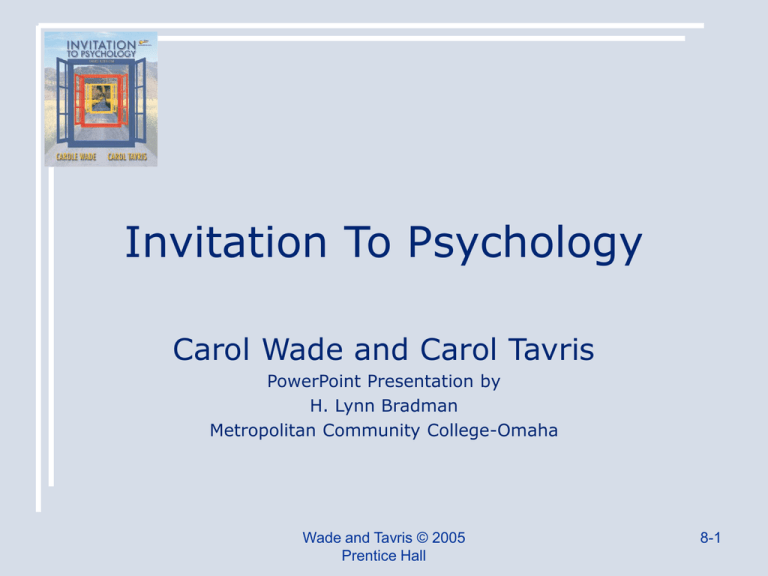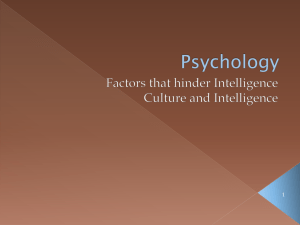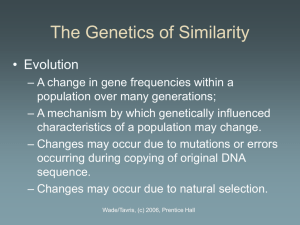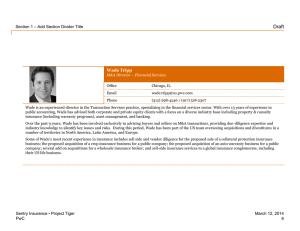What is Psychology?
advertisement

Invitation To Psychology Carol Wade and Carol Tavris PowerPoint Presentation by H. Lynn Bradman Metropolitan Community College-Omaha Wade and Tavris © 2005 Prentice Hall 8-1 Memory Wade and Tavris © 2005 Prentice Hall 8-2 Memory • • • • • • • Reconstructing the Past Memory and the Power of Suggestion In Pursuit of Memory The Three-Box Model of Memory How We Remember Why We Forget Autobiographical Memories Wade and Tavris © 2005 Prentice Hall 8-3 Reconstructing the Past Wade and Tavris © 2005 Prentice Hall 8-4 Reconstructing the Past • The Manufacture of Memory • The Fading Flashbulb • The Conditions of Confabulation Wade and Tavris © 2005 Prentice Hall 8-5 The Manufacture of Memory • Memory is selective. • Recovering a memory is not playing a videotape – Memory involves inferences that fill in gaps in recall. – We are often unaware we have made such inferences. • Source Amnesia: The inability to distinguish what you originally experienced from what you heard or were told later about an event. Wade and Tavris © 2005 Prentice Hall 8-6 The Fading Flashbulb • Even flashbulb memories, emotionally powerful memories that seem particularly vivid, are often embellished or distorted and tend to become less accurate over time. Wade and Tavris © 2005 Prentice Hall 8-7 The Conditions of Confabulation • Confabulation: Confusion of an event that happened to someone else with one that happened to you, or a belief that you remember something when it never actually happened. • Confabulation is most likely when: – you have thought about the event many times; – the image of the event contains many details; – the event is easy to imagine; – you focus on emotional reactions to the event rather than what actually happened. Wade and Tavris © 2005 Prentice Hall 8-8 Memory and the Power of Suggestion Wade and Tavris © 2005 Prentice Hall 8-9 Memory and the Power of Suggestion • The Eyewitness on Trial • Children’s Testimony • Memory Under Hypnosis Wade and Tavris © 2005 Prentice Hall 8-10 The Eyewitness on Trial • The reconstructive nature of memory makes memory vulnerable to suggestion. • Eyewitness testimony is especially vulnerable to error when: – the suspects ethnicity differs from that of the witness; – when leading questions are put to witnesses; – when the witnesses are given misleading information. Wade and Tavris © 2005 Prentice Hall 8-11 Misleading Information Study • Misleading information from other sources can alter what witnesses report. • Students were shown a picture of a man with straight hair, but heard a description that mentioned curly hair. • When the students were asked to reconstruct the face, a third added curly hair. Wade and Tavris © 2005 Prentice Hall 8-12 Children’s Testimony • If asked if a visitor committed acts that had not occurred, few 4-6 year olds said yes. – 30% of 3-year olds said yes • When investigators used techniques taken from real child-abuse investigations, most children said yes. Social Pressure, False Allegations Wade and Tavris © 2005 Prentice Hall 8-13 Memory Under Hypnosis • Hypnosis: A procedure in which the practitioner suggests changes in sensations, perceptions, thoughts, feelings, or behavior of the subject, who cooperates by altering his or her normal cognitive functioning. • Errors and pseudomemories are so common under hypnosis that the APA opposes use of hypnosis-based testimony in courts of law; few courts allow it. Wade and Tavris © 2005 Prentice Hall 8-14 In Pursuit of Memory Wade and Tavris © 2005 Prentice Hall 8-15 In Pursuit of Memory • Measuring Memory • Models of Memory Wade and Tavris © 2005 Prentice Hall 8-16 Measuring Memory • Explicit Memory: Conscious, intentional recollection of an event or of an item of information. • Implicit Memory: Unconscious retention in memory, as evidenced by the effect of a previous experience or previously encountered information on current thoughts or actions. Wade and Tavris © 2005 Prentice Hall 8-17 Explicit Memory • Recall: The ability to retrieve and reproduce from memory previously encountered material. • Recognition: The ability to identify previously encountered material. Wade and Tavris © 2005 Prentice Hall 8-18 Implicit Memory • Priming: A method for measuring implicit memory in which a person reads or listens to information and is later tested to see whether the information affects performance on another type of task. • Relearning: A method for measuring retention that compares the time required to relearn material with the time used in the initial learning of the material. Wade and Tavris © 2005 Prentice Hall 8-19 The Three-Box Model of Memory Sensory Memory: Fleeting Impressions Short-term Memory: Memory’s Scratch Pad Long-term Memory: Final Destination Wade and Tavris © 2005 Prentice Hall 8-20 Three-Box Model of Memory Wade and Tavris © 2005 Prentice Hall 8-21 Sensory Memory: Fleeting Impressions • Sensory Memory: A memory system that momentarily preserves extremely accurate images of sensory information. • Pattern Recognition: The identification of a stimulus on the basis of information already contained in long-term memory. Wade and Tavris © 2005 Prentice Hall 8-22 Short-term Memory: Memory’s Scratch Pad • Short-Term Memory (STM): In the three-box model of memory, a limited capacity memory system involved in the retention of information for brief periods; it is also used to hold information retrieved from long-term memory for temporary use. • Chunk: A meaningful unit of information; it may be composed of smaller units. Wade and Tavris © 2005 Prentice Hall 8-23 The Value of Chunking • You have 5 seconds to memorize as much as you can • Then, draw an empty chess board and reproduce the arrangement of pieces Wade and Tavris © 2005 Prentice Hall 8-24 Long-term Memory: Final Destination • Procedural memories: – Memories for performance of actions or skills. – “Knowing how” • Declarative memories: – Memories of facts, rules, concepts, and events; includes semantic and episodic memory. – “Knowing that” Wade and Tavris © 2005 Prentice Hall 8-25 Long-term Memory: Final Destination • Semantic memories: – General knowledge, including facts, rules, concepts, and propositions. • Episodic memories: – Personally experienced events and the contexts in which they occurred. Wade and Tavris © 2005 Prentice Hall 8-26 Conceptual Grid Wade and Tavris © 2005 Prentice Hall 8-27 Serial-Position Effect • The tendency for recall of first and last items on a list to surpass recall of items in the middle of the list. Wade and Tavris © 2005 Prentice Hall 8-28 How We Remember Wade and Tavris © 2005 Prentice Hall 8-29 How We Remember • Effective Encoding • Rehearsal • Mnemonics Wade and Tavris © 2005 Prentice Hall 8-30 Encoding • In order to remember material well, we must encode it accurately in the first place. • Some kinds of information, such as material in a college course, require effortful, as opposed to automatic, encoding. Wade and Tavris © 2005 Prentice Hall 8-31 Rehearsal • Rehearsal of information keeps it in short-term memory and increases the chances of long-term retention. Wade and Tavris © 2005 Prentice Hall 8-32 Rehearsal • Maintenance Rehearsal: Rote repetition of material in order to maintain its availability in memory. • Elaborative Rehearsal: Association of new information with already stored knowledge and analysis of the new information to make it memorable. Wade and Tavris © 2005 Prentice Hall 8-33 Mnemonics • Mnemonics can also enhance retention by promoting elaborative encoding and making material meaningful. • However, for ordinary memory tasks, complex memory tricks are often ineffective or even counterproductive. Wade and Tavris © 2005 Prentice Hall 8-34 Why We Forget Wade and Tavris © 2005 Prentice Hall 8-35 Why We Forget • • • • Decay Interference Cue-dependent Forgetting Psychogenic Amnesia Wade and Tavris © 2005 Prentice Hall 8-36 Decay • Decay Theory: The theory that information in memory eventually disappears if it is not accessed; it applies more to short-term than to long-term memory. Wade and Tavris © 2005 Prentice Hall 8-37 Forgetting Curve • Herman Ebbinghaus tested his own memory for nonsense syllables. • Forgetting was rapid at first and then tapered off. Wade and Tavris © 2005 Prentice Hall 8-38 Remembering Over Years • Marigold Linton tested her own memory for personal events over a period of several years. • Retention fell at a gradual but steady rate. Wade and Tavris © 2005 Prentice Hall 8-39 Interference • Retroactive Interference: Forgetting that occurs when recently learned material interferes with the ability to remember similar material stored previously. • Proactive Interference: Forgetting that occurs when previously stored material interferes with the ability to remember similar, more recently learned material. Wade and Tavris © 2005 Prentice Hall 8-40 Cue-dependent Forgetting • Cue-Dependent Forgetting: The inability to retrieve information stored in memory because of insufficient cues for recall. • State-Dependent Memory: The tendency to remember something when the rememberer is in the same physical or mental state as during the original learning or experience. Wade and Tavris © 2005 Prentice Hall 8-41 Psychogenic Amnesia • The partial or complete loss of memory (due to non-organic causes) for threatening information or traumatic experiences. Wade and Tavris © 2005 Prentice Hall 8-42 Autobiographical Memories Childhood Amnesia: The Missing Years Memory and Narrative: The Stories of Our Lives Wade and Tavris © 2005 Prentice Hall 8-43 Childhood Amnesia: The Missing Years • Childhood Amnesia: The inability to remember events and experiences that occurred during the first two or three years of life. • Cognitive explanations: – Lack of sense of self – Impoverished encoding – A focus on the routine – Different ways of thinking about the world Wade and Tavris © 2005 Prentice Hall 8-44 Memory and Narrative: The Stories of Our Lives • A person's narrative 'life story' organizes the events of his or her life and gives them meaning. • Narratives change as people build up a store of episodic memories, and life stories are, to some degree, works of interpretation and imagination. • The central themes of our stories can guide recall and influence our judgments of people and events. Wade and Tavris © 2005 Prentice Hall 8-45



